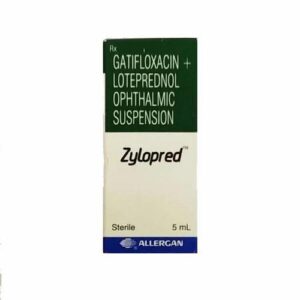GATIFLOXACIN + LOTEPREDNOL
Gatifloxacin: Gatifloxacin is a fluoroquinolone antibiotic that is used to treat various types of infections, particularly respiratory and urinary tract infections. It is available in tablet and solution forms.
Its mechanism of action involves inhibiting the enzymes DNA gyrase and topoisomerase IV, which are essential for bacterial DNA replication and repair. By interfering with these enzymes, gatifloxacin disrupts the bacterial DNA synthesis, ultimately leading to the death of the bacteria.
The recommended dose of gatifloxacin depends on the type and severity of the infection being treated. It is typically taken orally, with or without food, and the dosing frequency may vary from once daily to multiple times a day. It is important to follow the prescribed dosing instructions provided by the healthcare professional.
Like any medication, gatifloxacin can cause certain side effects. Common side effects may include nausea, diarrhea, abdominal pain, headache, dizziness, and a change in taste perception. These side effects are usually mild and temporary.
However, gatifloxacin has been associated with rare but serious side effects such as tendonitis and tendon rupture, particularly in elderly patients or those receiving concomitant corticosteroid therapy. It may also cause a prolonged QT interval in the heart’s electrical activity, which can lead to an increased risk of arrhythmias.
Furthermore, gatifloxacin should be used with caution in patients with a history of seizures, liver disease, or glucose-6-phosphate dehydrogenase deficiency, as it may worsen these conditions.
As with any medication, it is important to discuss any existing medical conditions and potential drug interactions with a healthcare professional before starting gatifloxacin. They can provide personalized guidance on the appropriate use, dose, and monitoring for this medication.
Loteprednol: Loteprednol is a corticosteroid drug that is primarily used to treat inflammation and pain associated with certain eye conditions, such as conjunctivitis, uveitis, and keratitis. It is available in the form of eye drops.
The mechanism of action of loteprednol involves its anti-inflammatory properties. It works by inhibiting the synthesis of inflammatory mediators and substances that cause inflammation, such as prostaglandins and leukotrienes. This helps reduce swelling, redness, and irritation in the eyes.
The recommended dose of loteprednol eye drops may vary depending on the specific eye condition being treated. However, the usual starting dose for adults is one to two drops in the affected eye(s) four times a day. The dosage may be gradually decreased over time as the condition improves.
As with any medication, loteprednol may cause certain side effects. Common side effects include temporary blurred vision, stinging or burning sensation in the eyes, eye discharge, dry eyes, itching, and increased sensitivity to light. These side effects are usually mild and tend to go away on their own.
Less common but more serious side effects may include eye pain, vision changes, eye infection, increased eye pressure, and allergic reactions. If any of these side effects occur or persist, it is important to seek medical attention immediately.
It is worth noting that loteprednol should only be used as prescribed by a healthcare professional. Prolonged or excessive use of corticosteroid eye drops can increase the risk of glaucoma or cataracts. Additionally, it is important to follow the prescribed dose and duration of treatment to avoid potential complications.

